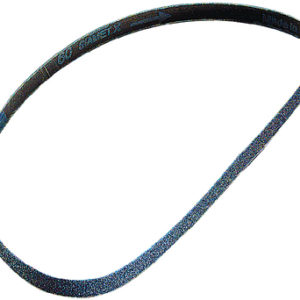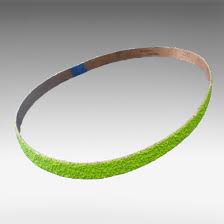What Are Dynafile Abrasive Belts?
Abrasive sanding belts are looped sheets of abrasive grit or sandpaper used for sanding, deburring, polishing and finishing wood and metal surfaces. These abrasives are used in electric belt sanders to deliver fast and efficient operation, minimizing the hard labor associated with wood and metalwork. They are the part of the belt sander that comes into contact with the workpiece, scraping layers from its surface.
At National Abrasives, Inc., we offer two types of Dynafile sanding belts, each with unique benefits and operations.
Ceramic Sanding Belts
Ceramic sanding belts have a uniform structure and facilitate cool grinding, making them ideal for handling heat-sensitive materials. These abrasives are self-sharpening and capable of breaking down surfaces in a controlled manner to deliver a consistent finish. You can use ceramic belts to sand various tough metals, such as stainless steel, aluminum casings and titanium alloys.
Ceramic belts significantly improve metal grinding quality and efficiency and provide the fastest cut rate of any other abrasive grain. Ceramic Dynafile belts also have exceptionally long life spans, lasting between 50% to 200% longer than other abrasive materials.
Zirc Dynafile Belts
Zirconia sanding belts, also known as zirc belts, are well suited for high-pressure grinding and machining applications. These abrasives have advanced cutting abilities and allow users to sand materials in any direction. Zirc abrasive belts deliver high-quality grinding on metals like stainless steel, aluminum, titanium, cast iron, carbon steel and nickel alloys.
Like ceramic belts, zirc Dynafile belts are self-sharpening but require higher sanding force, making them better suited for heavy-grinding hard surfaces than polishing. These abrasives are considerably tougher than aluminum oxide sanding belts and exhibit excellent heat resistance.
Why Buy Dynafile Abrasive Belt Tools?
Dynafile sanding belts help users achieve high-quality sanding due to their many functional benefits. When you purchase a ceramic or zirc Dynafile belt, you can expect to receive the following advantages.
Extensive Life Span
Ceramic and zirc sanding belts last several times longer than aluminum oxide abrasives. These Dynafile abrasive belts comprise a micrograin structure where smaller pieces break off during use, contributing to the belts’ longer life span. On the other hand, aluminum oxide belts dull with use, requiring more pressure for material removal as the grains dull.
Application Versatility
Dynafile abrasive belts are suitable for sanding a wide range of industrial surfaces, such as wood, metal, plastic, concrete, fiberglass and composites. These tools are commonly used around industrial and residential work sites.
Due to their versatile material handling capabilities, sanding belts are used in an extensive variety of applications, such as:
- Sanding.
- Grinding.
- Polishing.
- Deburring.
- Finishing.
- Material removal.
- Buffing.
- Paint stripping.
- Blending.
- Surface preparation.
Grinding Performance
The abrasive grains on sanding belts are stronger and sharper than those of grinding wheels, giving them greater grinding performance. They also exhibit excellent processing quality, ensuring a constant operational speed while producing less heat and requiring zero trimming. Because their blades are so sharp, Dynafile sanding belts have reliable cooling conditions that guarantee minimal surface roughness and high precision.
Operational Efficiency
The cost of grinding using a sanding belt is low due to its light weight, simple structure, small grinding force and low rigidity and strength requirements. Sanding belts’ machine powder utilization, large grinding ratios, small rotary inertia and high cutting speeds minimize energy consumption, making them highly energy-efficient.
These solutions also save users time with user-friendly operation and increased grinding efficiency. Sanding belts are also eco-friendly, producing minimal dust, noise pollution and resource waste. Due to the belts’ simple structures, abrasive belt grinding ensures operational safety.
Maximize Your Ceramic Sanding Belt’s Potential
The key to achieving the best sanding results with your sanding belt is knowing the right tips and tricks to make the process as seamless and efficient as possible. You can optimize your abrasive belt’s performance with the following tips:
- Clean your belt: Always make sure your sanding belt is clean to increase overall performance. Try applying a grease stick to the abrasive belt before working with metals, or use a rubber cleaner stick to remove loaded materials.
- Inspect your sander: Before you begin sanding, check your sander to ensure there are no bumps or divots in the drive drum, wheel or roller to prevent uneven sanding.
- Adjust your speed: Choose a sanding speed compatible with your application and desired results. Lower speeds will deliver greater maneuverability, while higher speeds enable you to cover a wider surface area with minimal effort.
- Sand forward and backward: Always sand from forward to backward rather than side to side. This technique prevents the sanding belt from skidding and minimizes belt and machine damage.
- Keep the sander moving: Constant movement prevents the abrasive belt from digging into your material’s surface and creating divots, delivering more consistent sanding.
Choosing the Best Grit for Your Abrasive Sanding Belt
An abrasive’s grit refers to the number, size and coarseness of the abrasive media on its surface. Higher grits have a higher number of grains, which produce a smoother surface finish. Lower grit sizes remove more material and generate a rougher finish.
Sanding belts can use a wide range of grits, ranging from 40 to 600. Each of these sizes is suited for different applications and produces different surface finishes:
- 40 to 60 grits: Grits within this range comprise a rough texture, making them ideal for heavy-duty sanding and finishing applications.
- 80 to 120 grits: Grits in the 80 to 120 range are medium- to fine-grade. This size is suitable for sanding bare wood, smoothing surfaces, removing blemishes and water stains and cleaning plaster.
- 320 to 600 grits: 320- to 600-grit abrasives are extra fine to superfine, making them useful for wood polishing and final finishing applications.
Buy Dynafile Sanding Belts Online From National Abrasives, Inc. Today
For dependable and efficient Dynafile abrasive belt tools, choose National Abrasives, Inc. We strive to provide our customers with the highest value by delivering top-of-the-line abrasive products with fast shipping, competitive pricing and excellent customer service.
Contact us to learn more about our zirc and ceramic sanding belts today!



